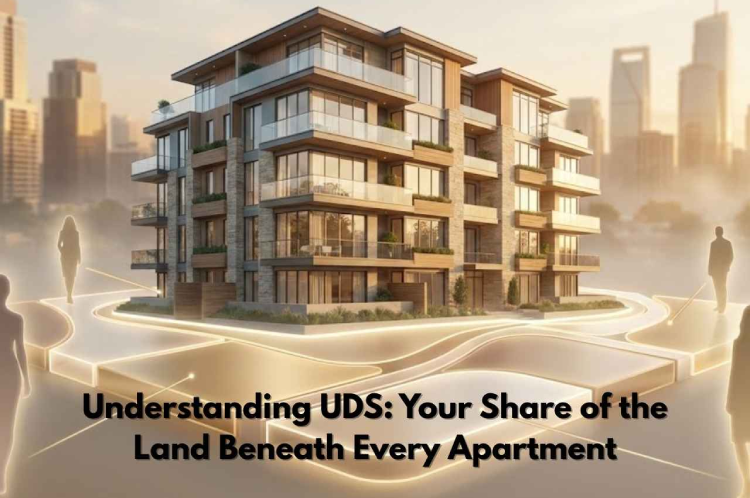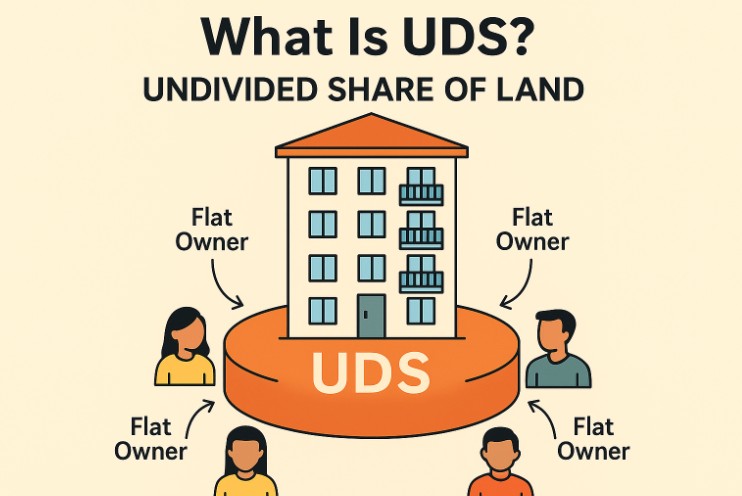
What Is UDS? A Simple Guide for Homebuyers
Posted on:
If you have started searching for a flat, you have probably heard this term at least once: UDS.
Some people nod like they understand it.
Many pretend they know it.
Most buyers quietly Google it later.
And that is okay.
Because UDS is not a word we use in daily life.
But it is one of the most important things to understand before you buy an apartment. It decides how safe your investment is, how much your property can appreciate, and what your family actually owns in the long run.
Let us break it down in the simplest way possible.
UDS Means Your Share of the Land
UDS stands for Undivided Share of Land.
When you buy a flat, you are not just buying the four walls, tiles, fittings, and paint. You are also buying a portion of the land on which the entire apartment project stands.
You cannot point to a spot on the ground and say, “This is my land.” It does not work like that.
The land is shared by everyone who owns a flat in that project. That is why it is called undivided share.
Think of the apartment land like a big birthday cake.
Each flat owner gets a slice.
The size of your slice depends on the size of your flat and how many flats share that cake.
That slice is your UDS.

A visual showing how every apartment owner shares a portion of the same land, known as the Undivided Share of Land (UDS).
Why UDS Matters More Than You Think
Most people look at square feet first.
They compare 2BHK vs 3BHK, hall size, balcony size, and kitchen layout.
All that is important.
But there is one simple truth in real estate:
Buildings age.
Land does not.
If you want clarity on what holds value over time, you may also find this useful:
How to pick a home that stays valuable for years.
The part of your home that quietly grows in value over time is the land.
Your UDS is your legal share in that land.
Here is why UDS is such a big deal for buyers:
1. It gives you real, legal ownership
Without UDS, you are almost treating the flat as just a box in the sky.
With UDS, you own a share of the land under that box.
That land share is what protects your investment and gives you a stronger title.
2. It affects your resale value
Two flats can look similar inside but have very different UDS.
The one with a better land share usually has a stronger resale value because buyers know land is what truly appreciates.
This is why many property advisors check a flat’s UDS before they check the interiors.
If you want to understand the patterns behind appreciation, here’s something linked:
What no one told you about Trichy’s property market trends.
3. It decides your share during redevelopment
If, after many years, the building has to be redeveloped or reconstructed, your benefits are usually calculated based on your UDS. That can decide:
- what size replacement flat you get
- how much compensation you are eligible for
4. It ties into your rights in common areas
Your UDS is linked to your co-ownership of:
- corridors and lobbies
- staircases and lifts
- club house, party hall, gym
- garden, play area, internal roads
You do not own these exclusively, but you share them as a co-owner along with others.
5. It is recognised under RERA and state rules
The Real Estate (Regulation and Development) Act, 2016 is a central law that aims to protect homebuyers across India. It requires developers to clearly disclose things like land area and rights in common areas and to execute a proper conveyance of land share and common areas to buyers or their association.
In Tamil Nadu, this is implemented through Tamil Nadu RERA (TNRERA) and the Tamil Nadu Real Estate (Regulation and Development) Rules, 2017, which specifically talk about how the undivided share of land should be conveyed in apartment projects.
This means UDS is not optional. It is part of the legal and regulatory structure that ensures transparency for buyers.
How UDS Is Calculated: The Simple Formula
Now the maths.
Do not worry, it is easier than it looks.
UDS = (Your Flat’s Built-up Area ÷ Total Built-up Area of All Flats) × Total Land Area
Let us put numbers to it.
Example
- Total land area of the project: 10,000 sq ft
- Total built-up area of all flats put together: 40,000 sq ft
- Your flat’s built-up area: 1,000 sq ft
Now apply the formula:
UDS = (1,000 ÷ 40,000) × 10,000
UDS = 0.025 × 10,000
UDS = 250 sq ft
On paper, your flat may be 1,000 sq ft.
In reality, your land ownership is 250 sq ft.
This 250 sq ft is not marked on the ground.
But it is written into your documents and protected by law.

A clear mind map explaining every major factor affected by UDS (Undivided Share of Land) in apartment ownership.
What Influences Your UDS
Your UDS is not random. It is shaped by how the project is planned.
1. Size of the land
Bigger land = more room for a strong UDS per flat, especially if the number of units is reasonable.
2. Number of flats
If too many flats are squeezed into a small piece of land, each owner gets a smaller slice.
Fewer flats on a decent-sized plot usually means better UDS.
3. Size of your flat
A 3BHK generally gets more UDS than a 2BHK, because its built-up area is higher.
4. Project planning and approvals
Good builders plan with open spaces, amenities, and proper approvals in mind.
This impacts how land and rights are structured, which in turn reflects in UDS.
Trusted and reputed developers usually offer transparent UDS allocation, which is why many homebuyers prefer established brands.
This is where choosing a credible developer matters. For clarity, here’s a reference on
how to identify the right builder in Trichy.
UDS and Long-Term Appreciation
In cities like Trichy and across Tamil Nadu, buyers are not only thinking about “Where will I live now?” They are thinking:
- “Will this home still have value after 10 or 15 years?”
- “If something happens to the building, what is my position?”
Here is the honest answer:
Flats with a healthy UDS and clear documentation tend to:
- retain demand better
- get sold faster in resale
- offer better negotiation power
- give more clarity during any redevelopment or legal issue
This becomes even stronger when paired with Trichy’s ongoing growth.
To understand what is driving prices up, read how infrastructure projects are transforming Trichy’s property market.
Flats with poor or unclear UDS often struggle later.
Common Mistakes Buyers Make With UDS
If you are a first-time homebuyer, these are the mistakes you want to avoid:
Mistake 1: Ignoring UDS completely
Focusing only on paint colours, balcony view, and layout is tempting.
But if you skip UDS, you miss the foundation of your ownership.
Mistake 2: Assuming all flats in a project have the same UDS
They do not.
A bigger flat usually has a bigger UDS.
Two buyers in the same building can have very different land shares.
Mistake 3: Not reading the sale deed carefully
Your sale deed must clearly mention:
- the land extent
- your undivided share of land
- your rights in common areas
If UDS is missing or vague, that is a red flag.
Mistake 4: Not checking if the project is registered under RERA
A RERA-registered project gives you far more transparency.
You can see sanctioned plans, land details and other disclosures on the state RERA website before you even sign.
These UDS-related mistakes often go hand-in-hand with broader errors many buyers unknowingly make.
If you want a deeper understanding, you can also read
Flat Buying Mistakes to Avoid in Trichy: 9 Things Nobody Tells You, a useful guide that covers everything from poor documentation to hidden costs and unclear builder communication.
How Much UDS Is “Good”?
There is no fixed number because every project is different.
But buyers usually look for:
- reasonable land share for the flat size
- a project that is not overcrowded
- clear documentation
Example ranges in many mid-sized projects:
- 2BHK: 200 to 400 sq ft UDS
- 3BHK: 350 to 550 sq ft UDS
Remember: Clarity + fairness matters more than the exact number.
A Simple UDS Checklist Before You Book
Keep this checklist ready:
- Ask for total land area
- Ask for total built-up area of all flats
- Confirm exact UDS in your sale deed
- Check RERA registration
- Verify land title documents
- Clarify rights in common areas
- Compare UDS between projects
If the builder hesitates to share details, be cautious
Final Thoughts: UDS Is the Real Strength Behind Your Flat
When you walk into a sample flat, it is easy to get impressed by decor, lighting, and furniture.
But the real strength of your home is something you cannot see: your land share.
UDS is that quiet strength.
It gives your home:
- long-term value
- legal security
- redevelopment rights
- resale confidence
So the next time you discuss a flat, do not hesitate to ask:
“What is the UDS for this apartment, and how has it been calculated?”
That one question puts you in a different league of homebuyers.
You are not just buying a flat.
You are owning your share of the land.
And if you're currently comparing flats in Trichy, understanding UDS will help you choose a home that stays valuable, secure, and future-ready for decades.






